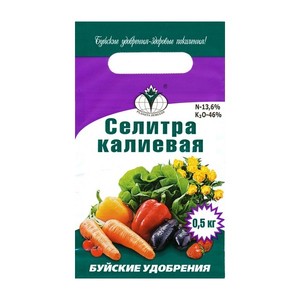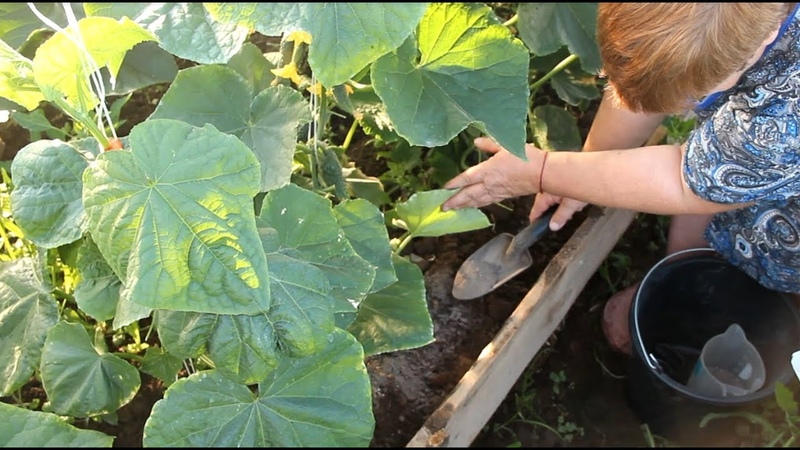Why potassium nitrate is useful for cucumbers during fruiting and how to use it correctly
For normal growth and fruiting, cucumbers need adequate mineral nutrition. One of the important elements for the health of the culture, the ripening of a quality crop is potassium. It is irreplaceable at any stage of the growing season. For top dressing, gardeners use agrochemicals with a high content of this trace element, among which potassium nitrate is popular.
The content of the article
Why do cucumbers need potassium nitrate
Potassium nitrate - universal fertilizer, which is used on almost any soil. The trace element is contained here in a form accessible to cucumbers, there are no unnecessary impurities. Top dressing with potassium nitrate will make cucumbers resistant to adverse factors, especially drought: the agent stimulates easier absorption of soil moisture.
Regular application of agrochemical balances the processes of photosynthesis, respiration, strengthens the root system of plants, accelerates the development and growth of green mass.
What is useful during fruiting
In the fertilizer, the optimal ratio of nitrogen and potassium was selected to obtain quality parameters in fruits:
- cucumbers do not crack;
- less formed barren flowers;
- yield increases;
- vegetables are even and beautiful;
- taste improves.
Fertilizer composition and properties
Potassium nitrate, potassium nitrate or potassium nitrate (formula of the mixture: KNO3) is a potassium-nitrogen agrochemical obtained by chemical means. It is a crystalline powder or white, odorless granules.
In a mixture of 2 active ingredients:
- nitrogen - 13%;
- potassium - 46%.
Nitrogen helps cucumbers grow faster and form a green mass.
The main advantages of potassium nitrate over other fertilizers with the same trace element:
- does not contain chlorine, which is important for chlorophobic cucumbers;
- well soluble in water;
- low toxic.
Potassium nitrate is a flammable and explosive substance, therefore it is stored in a cool dry room, away from sources of heat and fire. For the same reasons, fertilizer is not mixed with organic matter.
Important! The room where the agrochemical is contained is kept at a humidity of 60–65% so that the agent does not harden.
Potassium deficiency symptoms
With a lack of this element, the leaves of cucumbers become smaller in size, become pale, turn yellowcovered with brown spotslike burns around the edges and die off. The greater the need for potassium in the crop, the more stains on the plants.
The lack of an element appears on the lower leaves, since potassium is sufficiently mobile and, with a limited supply, moves to the young parts of the bushes. In hot weather, the manifestation of nutritional deficiencies increases. Such cucumbers before others feel the need for water, wither.
Potassium deficiency affects the quantity and quality of the crop the most. Flowering is accompanied by an abundance of barren flowers and partial withering away of the ovaries. Fruits grow small, uneven in diameter, crooked.
How to properly prepare a solution
The dissolved substance replenishes the nutritional balance much faster. Fertilizer in liquid form is used in case of visible signs of potassium deficiency in the form of foliar top dressing.
For the procedure to be beneficial, it is important to know the exact dosage when preparing the working fluid and follow the instructions on the pack of the agrochemical.
Proportions and instructions
The main dosages of the substance:
- For foliar dressing use more concentrated solutions: 25-30 g of the mixture per 10 liters of water. The solution is consumed on the day of preparation.
- When watering under the root, the dosage is reduced to 15–20 g / 10 l.
- For application to the soil in a dry form (dry dressing, autumn digging of soil on the site and in the greenhouse, preparation of soil mixture for seedlings) use 15–20 g / m2.
It is better to use powder fertilizer for preparation of liquid top dressing, and to apply granules to the soil in dry form. Granular potassium nitrate is more slowly saturated with moisture and has a longer shelf life.
Potassium nitrate for cucumbers during fruiting
During the flowering period, future cucumbers are laid. How many of them there will be and how they will grow depends on the chosen variety, the efforts of the gardener and good nutrition. How to feed vegetables at this stage of the growing season? Potash dressings are applied both at the root and by spraying the plants, depending on the type of soil in the garden and the health of the crop.
Root dressing
It is used on light types of soils, as it gives quick results:
- To speed up flowering, the cucumbers are fertilized in the phase of 2-3 true leaves. The dose for the solution is 2-3 tbsp. l. (15–20 g) per 10 liters of water.
- When the first flowers appear, 20 g of potassium nitrate and 30 g of superphosphate are dissolved in 10 liters of water. Plants are fed with this remedy after watering. This amount of liquid is enough for 15 bushes.
- At the time of growth of the bulk of the fruits, feeding is repeated (two weeks after the second fertilization).
Each subsequent feeding begins at the appropriate time: between procedures, they are kept for at least two weeks.
Attention! If the cucumbers are regularly fed with potassium nitrate, then root watering will be sufficient.
Greenhouse vegetables need potassium nutrient more often than those grown outdoors. The reasons for this are simple: the necessary elements do not get in with the rain, watering washes them from a limited area, and an enclosed space increases the risk of fungal diseases. If in the open ground with a good condition of cucumbers, only top dressing is left during the fruiting period, then all 4 are carried out in the greenhouse.
Foliar dressing
On heavy and clayey soils, spraying with a solution of nitrate will be more effective. The same method is used if visible signs of potassium starvation are seen on the plants. For spraying, the granules or powder are dissolved in water. In order not to burn the leaves, prepare a less concentrated solution: 1-2 tbsp. l / 10 l of water.

Plant processing rules:
- spray in the morning and evening hours;
- apply top dressing only in dry, calm and cloudy weather;
- use personal protective equipment (gloves, glasses), and after work, wash your face and hands thoroughly with soap and water.
Leaves are processed no more than 2-3 times during the entire growing season.
Tips from experienced summer residents
Many farmers have appreciated the benefits of fertilizing cucumbers.
Oleg, Kostroma region:«I grow cucumbers in a greenhouse for sale, so a consistent yield is of great importance. At first I fed the cucumbers at the time of fruit setting with potassium chloride, but in 2017 I decided to try potassium nitrate from the Fasco company. I liked that the fertilizer is already in liquid form. It is a pleasure to prepare the solution: I measured the cap on a bucket of water, and that's it! The price of the fertilizer is higher than that of cheap analogues, but in my case the investments were justified. "
Olga, Moscow region:“I have acidic soil in my garden. Fertilizer for cucumbers is good, but if you look at it from the point of view of agricultural chemistry (I'm a chemist by training), then only one element is used - potassium. Nitrogen does not work on acidic soils, but on purely alkaline soils, on the contrary, potassium will be a dead weight. For me, a pensioner, it is also expensive. I feed my cucumbers with ash and I am happy with the result. "

Anastasia, Klin:“My husband and I are just starting to garden. The plot got with poor soils.In the fall, they brought in manure, and in the spring they planted cucumbers under the film. The culture was growing and had already begun to set the first fruits. We were about to harvest this weekend when we found the lower leaves turned yellow. Whatever we did: watered, looked for pests, used home remedies, and the plants stopped growing and fruit set. A neighbor helped by advising them to spray them with potassium nitrate. I did everything as in the instructions. After 4-5 days, the cucumbers came to life and continued to set the ovaries. "
Conclusion
Potassium nitrate is widely used in large areas and is effective both when applied to the soil and when irrigating cucumbers. Fertilizer is produced in dry and liquid form. To be sure of the harvest, the product is used according to the instructions, applied during flowering and fruit setting. It is important to remember that an excess of nitrogen and potassium is harmful to plants, as well as their lack.